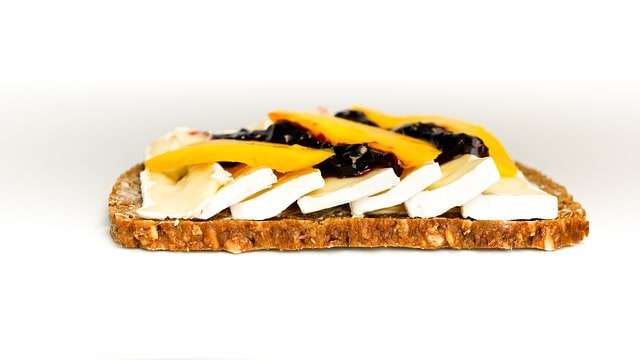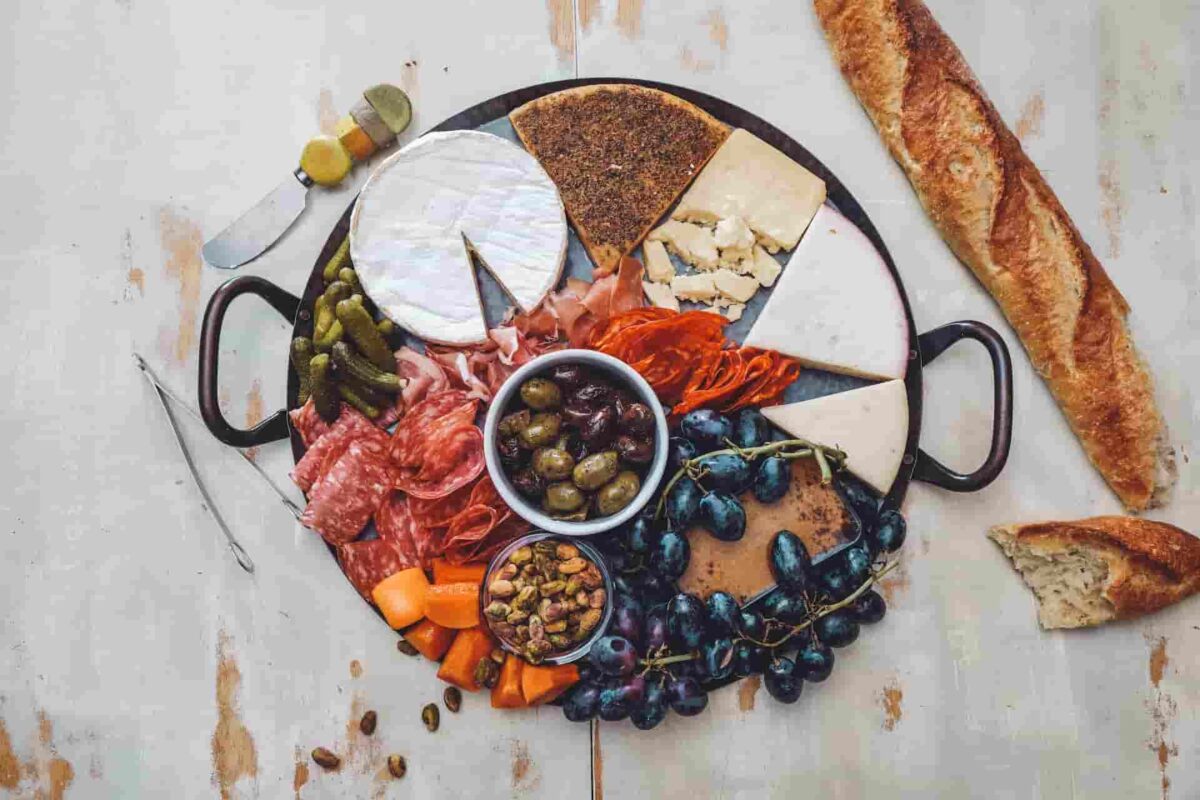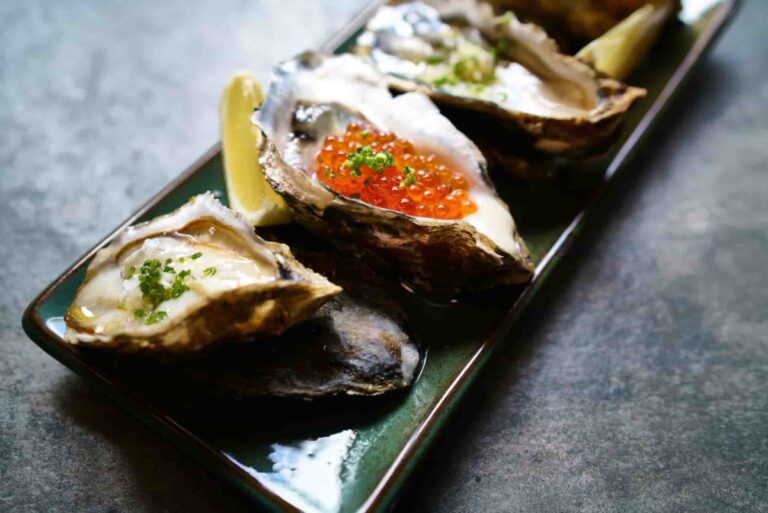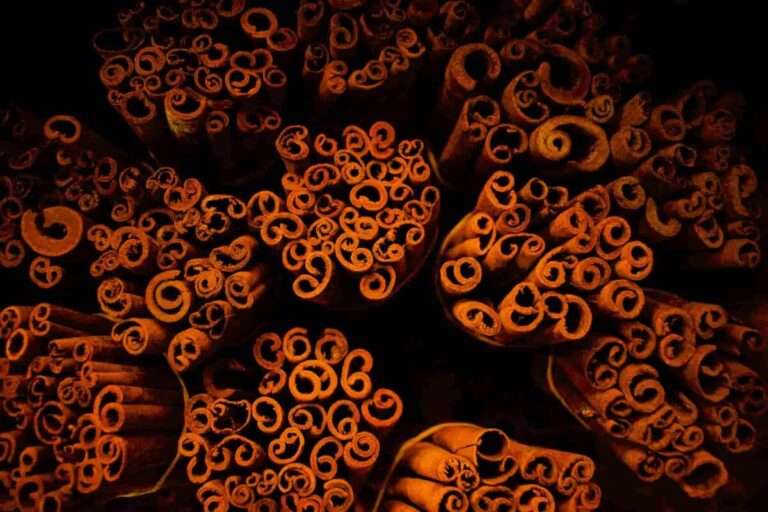Brie 41 top professional insight
Did you know that the French government officially recognises just two varieties of brie that may be produced and sold?
- In spite of the fact that there are many different kinds of brie, the French government only legally recognises two kinds of cheese as being eligible to be marketed under the term “brie”: brie de Meaux and brie de Melun.
- Brie de Meaux is an unpasteurized brie. Since the 8th century, it has been produced in the town of Meaux, which is located in the Brie region of northern France. It was formerly known as the “Queen’s Cheese,” but after the French Revolution, it became known as the “Queen of Cheeses,” and it was enjoyed by both the peasantry and the nobility.
- Brie de Melun is supposed to have a stronger taste and a more pungent scent than Brie de Meaux, despite the fact that it is thought to be smaller than Brie de Meaux. It is made from milk that has not been pasteurised. There is also a kind of Brie de Melun known as “Old Brie” or “Black Brie” that may be purchased. In 1980, it was designated as an AOC, which affords it some protection.
- It is said that in the eighth century, the Emperor of France, Charlemagne, had this soft cheese for the very first time at a monastery in Reuil-en-Brie and fell immediately in love with its velvety texture and full-bodied flavour. Brie is not an exception to the rule that the favourites of rulers will ultimately become the favourites of the people.

Brie nutrition values and health benefits
- The high levels of protein, vitamins, and minerals that are found in brie cheese are what make its many positive health effects feasible. Casein protein, vitamin B12 for the creation of energy, calcium for strong bones, and vitamin A for better immune system response are all found in high concentrations in brie cheese, making it a good source of all of these nutrients. A balanced diet that includes brie cheese may help one maintain their weight and is also beneficial to their health.
- Casein is a milk protein that can be found in most cheeses, including brie cheese. It is a high-quality protein that is well-liked in the bodybuilding and fitness circles owing to the fact that its benefits in protein fuelling endure for an extended period of time. Because casein protein digests more slowly than other types of protein, it is well suited for consumption during extended fasts, such as overnight.
- It is also rather filling, allowing you to feel full for longer while consuming fewer calories overall. Numerous studies have shown that eating a diet high in casein may facilitate weight loss, particularly when combined with an active lifestyle. Because a diet high in protein helps people feel fuller for longer, following such a diet may help people make healthier food choices and consume fewer calories overall. overall
- The savoury cheese known as brie is loaded with the vital vitamin B12, also known as cobalamin. Vitamin B12 is essential for the production of new DNA as well as the healthy operation of nerve cells. Because the body is unable to produce B12 on its own, the only way to receive it is through the food you eat.
- If you don’t get enough vitamin B12 in your diet, you run the danger of developing a condition known as megaloblastic anaemia, which occurs when your body is unable to deliver oxygen effectively to its important organs. This ailment causes a person to feel weak and exhausted.
- Calcium intake from a single serving of brie cheese meets 5% of the recommended daily amount. Calcium is an essential element that plays an important role in the formation, maintenance, and proper growth of healthy bones. According to the findings of certain studies, taking calcium supplements and increasing one’s consumption of foods high in calcium may help enhance bone mineral density and strengthen bones. If you do not get enough calcium, there is a possibility that your bones may become more fragile, which will increase your likelihood of developing osteoporosis.
- Vitamin A, which is soluble in fat, plays an important role in the maturation and functioning of the immune system. It contains potent anti-inflammatory properties that improve the response of the immune system and help cure infectious disorders such as the common cold and stomach flu.
- In spite of the fact that brie cheese is rich in saturated fat, it also includes a variety of other nutrients, such as protein, calcium, and vitamin D, that may be beneficial to the health of the heart. In addition, preliminary studies suggest that full-fat dairy foods like brie cheese may be beneficial to the cardiovascular system.
- According to the findings of a study, more than 50 million individuals suffer from food allergies. In point of fact, food allergies affect around 4% of adults, while up to 6% of youngsters suffer from the condition. Brie is produced using milk, which means that anyone who suffers from a milk allergy should steer clear of eating it since milk is one of the top eight food allergens.
- The amount of salt in Brie cheese is rather high. Before incorporating it into your diet, those of you who have high blood pressure or are on a diet low in sodium should search for choices that contain less salt or speak with a healthcare professional.
100g of brie has 334 calories(1397kj), 21g protein, 28g fat, and 0g carbs including 0g fibre.
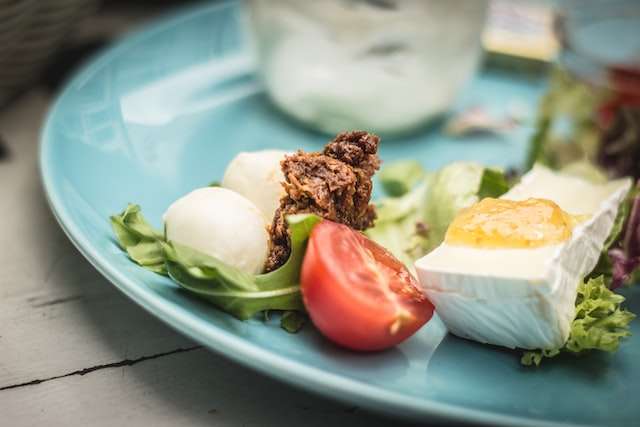
How to store brie and how to buy them
- Brie should be kept in the refrigerator, much like other types of cheese, such as feta or blue cheese. The product may be stored safely in its original packaging if it has not been opened.
- After you have removed the wrapping from the wedge of brie, the most important thing to keep in mind is to store any remaining brie in an airtight container.
- A proper wrap will keep the dry air and pungent scents from the refrigerator out while sealing in the wetness. Additionally, it stops mould spores from dispersing throughout the refrigerator and contaminating the food that is stored within.
- In most cases, you may simply use the original wrapper to repackage the remaining cheese. If you have any questions about this, feel free to contact us.
- Last but not least, the optimal serving temperature for brie is room temperature. As a result, it is generally recommended to remove it from the refrigerator about half an hour before serving.
- It seems that most people agree that you shouldn’t put soft cheeses in the freezer. However, if the alternatives are to freeze it or let it rot, the decision to freeze it is unquestionably the superior one. When thawed, the texture will be different, much as it is when cottage cheese or yoghurt are frozen, as well as when many other types of dairy products are frozen. As a result of the cheese’s tendency to crumble, brie may not be the best option for use in a sandwich or as a side dish for breakfast. On the other hand, it ought to function rather well in prepared foods such as casseroles or stews.
- Although the cheese has a “best-by,” “use-by,” or “sell-by” date, it is not in your best interest to consume it as soon as you purchase it, in contrast to practically every other kind of food product. On the other hand, many manufacturers suggest consuming it very close to the date printed on the bottle for the highest possible quality. Please be aware that there is very little to no difference in terms of shelf life between a brie that has been opened and one that has not been opened. A wedge that has not been opened will continue to ripen at the same rate as one that has been opened.
- Check for the following symptoms to determine if the brie cheese you have stored in the refrigerator has gone bad:
- First things first, inspect the cheese for any symptoms of mould that aren’t typical of white-mould cheeses. That refers to any spores that are either green or blue and are on the surface. Throw away any remaining cheese if there is any.
- Assuming that the outside is satisfactory, you should cut a slice and evaluate its overall quality. You should toss it away if it has changed texture, if it smells bad, or if the colour has become darker.
- Please keep in mind that the brie cheese will continue to develop its flavour even after it has been stored. Therefore, even while it may still be totally safe to consume after two or three weeks have passed since the date printed on the label, the flavour will most certainly no longer be acceptable in any way.
- If you find that the flavour is not satisfactory, it is best to just give up and let it go to waste.
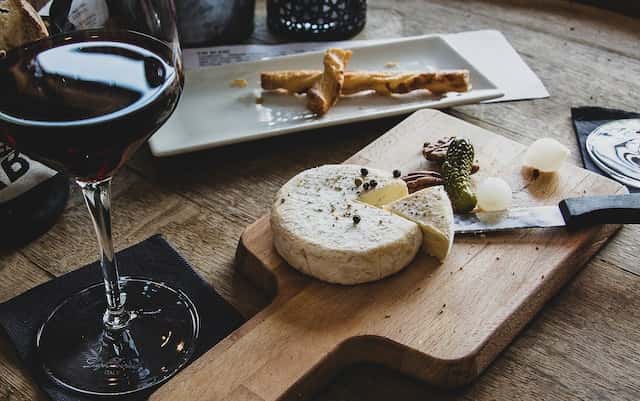
Cooking techniques, secrets, and tips from the kitchen
- The skin of brie is crumbly and has a somewhat bitter flavour, but despite these characteristics, it does not overly detract from the melty pleasure of the cheese. If you haven’t tasted the rind before, you should definitely give it a go. Not everyone enjoys eating the rind. It is important to keep in mind that the flavour deteriorates as the brie ages, so it is best to sample it on a fresh slice.
- Keep the brie at room temperature for one hour after removing it from the refrigerator. Take it out of the refrigerator and let it sit at room temperature for a while. It becomes lovely and creamy, allowing you to enjoy the full potential of the taste. A slice that has been stored in the refrigerator for a few days may develop an ammonia flavour. However, this flavour may be mitigated by warming the slice slightly.
- You are now enjoying a French cheese, so pairing it with a delicious French champagne is a safe bet.
- You might pair brie with a wine that is sweet and sour, like pinot noir, but you could also get yourself a hearty lager.
- In the event that you do not partake in the consumption of alcoholic beverages, you might want to think about pouring some fruit juice, such as grape or apple, to go with the mild taste of the cheese.
- Soft cheeses like brie tend to mix nicely with dry, fruity wines like Riesling, Marsannay, or Viognier. A lighter red wine such as pinot noir works well because of its delicate but rich taste, which provides a contrast to the cheese’s mellow flavour.
- Brie may be baked to make it easier to spread and make it softer.
- There are many different methods to prepare an appetiser with baked brie, but the first step is to place a soft brie on a baking sheet that has been coated with parchment paper and heated to 350 degrees Fahrenheit (177 degrees Celsius).
- Wait for it to become more pliable and start bubbling. If you forget about it for too long, it could turn into a gloppy liquid, so be sure to check on it often.
- You may either add the toppings before you bake the brie in the oven or after. Honey, fruit preserves, fresh herbs, and nuts in crumbled form are some of the toppings that you might try.
- By removing the top rind of the cheese, you might transform the brie into a spreadable version suitable for dipping. It is important that the wheel form of the brie be preserved, thus keeping the remaining rind intact.
- The molten sweetness may then be eaten by dipping crackers into it or by scooping it out with a spoon.
- In order to make brie en croute, you must first wrap a tiny wheel of brie in puff phyllo dough and then bake the dish in the oven until it is golden brown.
- Before encasing the brie in pastry, there is a wide variety of garnishes that may be applied to the surface of the cheese.
- After you add them, you should first remove the peel off the top of the brie.
- When you are ready to bake it, whip an egg and brush it over the pastry dough to seal it over the brie.
- Then fold the pastry dough over so that it covers the brie completely.
- For instance, as an appetiser for the holidays or throughout the fall and winter, you may top the brie with some cranberry sauce.
- You may serve the brie by slicing it into wedges and eating it as is, or you can place it on crackers and serve it that way.
- Apples, grapes, and pears are some examples of fruits that match well with wine because they have a low level of acidity. The combination of brie with fruit, both fresh and dried, is delicious. You might also try pecans that have not been salted, walnuts that have been candied, and a little honey. It is possible to use any sort of preserve or jam, but the ones that perform the best are those that are both sweet and acidic. Some examples are figs, cherries, and mixed berries.
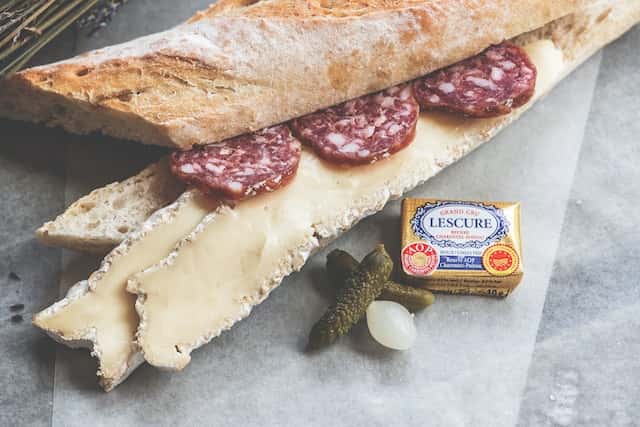
History of brie from the beginning until today
- The Brie de Meaux is the most well-known kind of Brie and, in our humble view, the finest. This beautiful, buttery, and earthy cheese has a long and illustrious history in France, and has even been served to royalty on several occasions. Even though it has been around for over a thousand and two hundred years, Brie de Meaux is still manufactured the old-fashioned way by artisans about 30 miles east of Paris in the area of Ile-de-France.
- The monks of the Priory of Rueil en Brie were responsible for the original creation of Brie De Meaux AOC in the Middle Ages. In 774, the French Emperor Charlemagne visited the priory and had some of the cheese there; he liked it so much that he had it sent regularly to his castle in Aachen, thereby launching the institution’s fame.
- As a New Year’s present for his whole court in 1217, King Philippe-Auguste ordered two hundred rounds of Brie de Meaux because he thought it was so good. A fan of the cheese but not of France, the poet Eustache Deschamps once said, “Brie de Meaux is the only nice thing to come out of this nation.”
- Furthermore, Louis XVI wasted valuable minutes during his legendary escape from his incarceration at the chateau of Sausse, Varennes, in order to satisfy his insatiable stomach with Brie and red wine.
- Historically, Brie de Meaux’s popularity extends beyond France; even Henry IV became enamoured with it. After a meal with the French queen in the mediaeval castle of Meaux in February 1594, King Henry VIII of England first tasted Brie.
- The tradition says that King Louis XIV preferred sharing a Brie with his wife, Queen Margot, rather than with his lover, Gabrielle d’Estrées, and that, as a result, the Queen insisted on serving the cheese whenever possible.
- The popularity of Brie de Meaux, however, skyrocketed in the nineteenth century. According to legend, after the collapse of the French Empire, Talleyrand, a French diplomat in the 19th century, asked for a break from dividing up the countries in order to conduct a cheese contest at one of history’s finest feasts, the Congress of Vienna.
